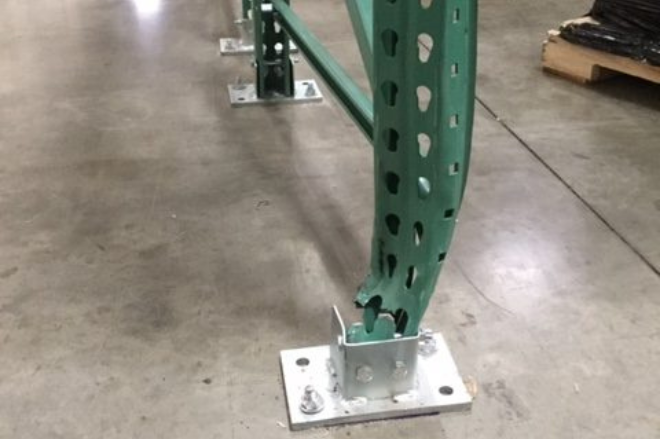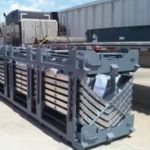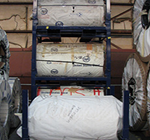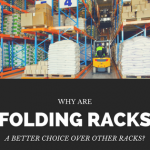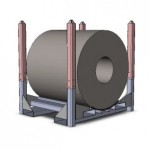How to Identify and Repair Damaged Pallet Racking in Your Warehouse?
Pallet racking is the backbone of modern warehousing and storage facilities, playing a pivotal role in the efficient organization, utilization and management of space. These towering steel structures might not always be in the spotlight, but they ensure that products are stored securely and retrieved easily. Let's understand the world of pallet racking and explore the crucial role it plays in the logistics and storage industry.
Pallet racking is the backbone of modern warehousing and storage facilities, playing a pivotal role in the efficient organization, utilization and management of space. These towering steel structures might not always be in the spotlight, but they ensure that products are stored securely and retrieved easily. Let’s understand the world of pallet racking and explore the crucial role it plays in the logistics and storage industry. Also, know the critical need for maintaining the integrity of these racks to ensure both operational efficiency and safety within your warehouse or storage facility.
Common Causes of Pallet Rack Damage
Overloading: Overloading is one of the most common causes of pallet rack damage, when racks are loaded with weights exceeding their specified capacity, it can lead to bending or even structural failure. Overloaded racks compromise the integrity of the system and pose a significant safety risk.
Forklift Collisions: Forklifts are essential for material handling in warehouses, but they can also be a common source of damage. Accidental collisions with pallet racks, particularly when traveling at high speeds or carrying heavy loads, can dent, twist, or displace rack components.
Improper Loading: Incorrectly loaded pallets can create stress points on the rack and cause pallet rack damage. This happens when the weight is unevenly distributed or when items overhang the pallets.
Poor Rack Installation: Racks that are not installed correctly are more susceptible to damage. This includes issues such as failing to anchor the racks securely to the floor, not following manufacturer guidelines, or using incompatible components.
Regular Wear and Tear: Pallet racks are subject to wear and tear over time, even with proper usage. Factors like corrosion, rust and metal fatigue can weaken rack components, reducing their load-bearing capacity and structural integrity.

Signs of Damaged Warehouse Racking
Recognizing signs of damaged warehouse racking is crucial, for ensuring an effective storage space. Below are a few signals that might suggest damage to warehouse racking:
Bent or Twisted Uprights: Vertical supports that appear visibly curved, twisted or leaning indicate damage. Could jeopardize the stability of the rack system.
Damaged Beams: If horizontal beams display signs of bending, cracking or warping it can compromise the strength of the structure. Potentially lead to failure when under a load.
Loose or Missing Bolts and Fasteners: Loose or missing bolts, screws or other fasteners can result in racks raising the risk of collapse.
Rust and Corrosion: The presence of rust or corrosion, on metal components, over time can weaken the rack system. Should be addressed promptly.
Cracks or Splits: Cracks or splits in the racking materials, including metal and wooden components, indicate structural weakness and potential failure points.
Misaligned Components: Beams or uprights that are not properly aligned may suggest that the racking system has been subjected to impact or overloading.
Regular inspections and prompt repairs are essential to ensure the safety and longevity of warehouse racking systems. If any of these signs are detected, it’s important to address them immediately to prevent accidents and ensure compliance with safety regulations. Damaged warehouse racking not only impacts your operations but also carries potential legal consequences. Therefore, it is crucial to promptly address any damage to ensure both operational efficiency and compliance with safety regulations.
Tools and Materials Used for Pallet Rack Repair
Repairing pallet racks typically requires a few essential tools and materials to ensure safety and effectiveness. Here’s a list of common items you might need to perform pallet rack repair:
Wrenches and Sockets: These are essential for loosening and tightening bolts and nuts during disassembly and reassembly of rack components.
Pallet Rack Beams and Uprights: Replacement beams and uprights are necessary if the damage is severe and requires replacing entire sections of the rack.
Welding Equipment: Welding machines, electrodes and safety gear are needed if the damage can be repaired by welding.
Bolt Cutters: Bolt cutters are used to remove damaged or sheared bolts, making it easier to disassemble and replace components.
Measuring Tools: Tape measures, levels and squares help ensure that replaced components are aligned correctly, maintaining rack stability.
Replacement Hardware: Bolts, nuts, anchors and other fasteners are necessary for securing components and ensuring the stability of the rack after repair.
Some Optional Equipment for Pallet Rack Repair
Pallet Jack or Forklift: For safely removing and repositioning pallets during repair.
Wire Brush: For cleaning rusted areas before applying paint or coating.
Steps to Repair Damaged Pallet Racking
Repairing damaged pallet racking is a methodical process that involves several critical steps to ensure the safety and integrity of the storage system. Below are the steps involved in pallet rack repair:
Step 1: Empty the Rack
The first step to repair damaged pallet racking is, to empty the damaged rack of all stored items. This step ensures the safety of personnel working on the repair and prevents further damage to the stored goods. Items should be relocated to a safe area and care should be taken to balance the load during transfer.
Step 2: Assess the Damage
A thorough assessment of the damaged pallet racking involves inspecting the rack for both visible and hidden damage, such as bent beams, twisted uprights, or sheared bolts. Documenting the extent of the damage is essential for planning the repair process effectively. Minor damage may be repairable, while extensive damage may require component replacement.
Step 3: Procure Replacement Parts
Based on the assessment, you’ll need to procure replacement parts if damage is severe. This includes beams, uprights, bolts, nuts and any other components necessary to restore the rack’s structural integrity. Ensure that replacement parts are compatible with the existing rack system and meet the manufacturer’s specifications.
Step 4: Disassemble the Damaged Section
With replacement parts on hand, begin the repair by carefully disassembling the damaged section of the rack. Use appropriate tools, such as wrenches and socket sets, to loosen and remove bolts and nuts. Take care not to damage other components during disassembly.
Step 5: Replace or Repair Components
Replace any damaged components with the new ones you’ve procured. If the damage is minor and can be repaired by welding, use welding equipment to restore the strength and stability of the damaged sections. Ensure that all replacement or repaired components are properly aligned and securely fastened according to manufacturer guidelines.
Step 6: Reassemble and Inspect
Reassemble the rack following the manufacturer’s assembly instructions. Use measuring tools like tape measures and levels to ensure that the components are correctly aligned and level. Conduct a thorough inspection of the repaired sections to verify that all components are securely fastened and that there are no visible defects or misalignments.
Step 7: Load the Rack Safely
Once the rack is fully repaired and inspected, it’s time to safely reload it with stored items. Ensure that the load is evenly distributed, and the weight does not exceed the rack’s specified capacity. Pay attention to weight distribution and adhere to safety guidelines for stacking and securing items on the rack.
Benefits of Warehouse Rack Repair
Warehouse rack repair is crucial to ensure safety improve efficiency and enhance cost effectiveness in warehouse activities. Here are the main advantages:
- Cost-Effectiveness: Fixing damaged racks is often a budget option, than completely replacing them. It can help prolong the lifespan of the existing racks, which ultimately saves money on buying ones.
- Safety Improvement: Making sure that racks are maintained enhances safety in the workplace by lowering the chances of collapses or structural issues. This is crucial, for safeguarding both employees and stored inventory.
- Operational Efficiency: Maintaining racks properly contributes to operations by making it easier to access stored items and maximizing storage space. This in turn can enhance inventory management and workflow efficiency.
- Compliance: Keeping racks in shape also ensures that businesses meet safety regulations and standards mandated by bodies. By doing they reduce the risk of facing fines or penalties for non-compliance.
- Sustainability: Repairing racks aligns with sustainability goals by reducing waste and the environmental impact associated with manufacturing and disposing of new materials.
- Preservation of Inventory: Stable racks help prevent damage to stored inventory, reducing the risk of product loss and minimizing operational disruptions.
- Enhanced Reputation: Maintaining a safe and well-organized warehouse reflects positively on the business, enhancing its reputation among customers, suppliers, and regulatory bodies.
Overall, warehouse rack repair not only addresses immediate safety concerns but also supports long-term operational efficiency and sustainability goals.
Pallet racking forms the backbone of efficient warehousing and storage operations and any damage to these structures can compromise not only the safety of personnel but also the integrity of valuable inventory. It is paramount that warehouse and storage facility managers prioritize the safety of their employees and the preservation of their investments by conducting regular inspections, promptly addressing damage and adhering to manufacturer guidelines. By taking these measures, we can ensure not only the longevity of pallet racking systems but also the security and efficiency of the entire storage process, ultimately leading to more successful and sustainable operations.
SPS Ideal Solutions specializes in pallet rack repair and warehouse safety solutions. Rely on our experts for inspection, maintenance, and long-term rack safety.
FAQs :
1. How can I tell if my pallet racking is damaged?
Check for visible signs like bent uprights, cracked beams, rust, or loose bolts. Regular inspections help identify these early before they lead to collapse or failure.
2. What should I do first when I notice rack damage?
Stop using the affected rack immediately and unload it. Then, assess the damage or call a professional inspection service to determine if repair or replacement is needed.
3. Is it safe to repair pallet racking in-house?
Minor repairs like tightening bolts can be done internally, but major structural damage should always be handled by certified rack repair specialists to ensure compliance and safety.
4. How often should warehouse racks be inspected?
Conduct visual inspections weekly and comprehensive professional inspections every 6 to 12 months depending on warehouse activity and forklift traffic.
5. Why should I repair instead of replacing damaged racks?
Repairing racks is cost-effective, faster, and more sustainable, extending the life of your system while maintaining safety and compliance standards.
About The Author

